|
Hello and Hoppy Quilting! This week we will be traveling to Clinton Missouri for the Greater Golden Valley Guild Quilt SHow! If you are in the this Friday and Saturday, stop by and say hello!
0 Comments
 This year we are going to be vending at AQS Quilt week in Paducah, April 27-30. We are in Booth 4314, in the Pavilion better known as the Bubble! As you may already know, Paducah is home of the Nation Quilt Museum & Hancocks of Paducah & Calico Country Sew & Vac! We hope you will stop by and see us in Booth 4314! It is sure to be a week packed full of fun, fabulous quilts, special exhibits and oh so much more. Can't wait to see you there!  AQS Quilt Week Branson here we come! Ok, well coming up very soon, March 23-25,2022! This is a new venue for AQS and we hope to see some of you there! We are participating in the I AM AQS for AQS members, make sure to bring your AQS card with you an see what special we have just for you! We are excited to see people in person again, we are in Booth 1010, come by and see us! 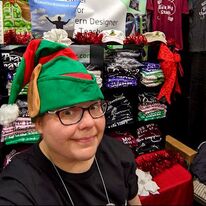 If you are reading this you made it through another tough year in what is become a new norm around the world. One of the bright points that I saw happening over these past two years is that people slowed down. They let go of so many of the things that kept them darting from one place to another and not taking time for themselves. I guess I am trying to see the silver lining in all this madness, and re-prioritizing what really matters in life. As people slowed down, they started picking up old hobbies, finishing the half made WIP's (work in progress), started new ones finally getting around to all these projects they kept saying they would "get to soon", but never did. The soft crafts in particularly became more popular then they had it some time and I have to say it warmed my heart. I love art in all art forms because it is an extension of who you are as person. Let that creative person out already. You don't have to be perfect you just need to try and have fun. I mean come on, look at the pic, I wore an elf hat helping a dear friend, Rona the Ribbiter, in her Christmas themed booth at OSQE Nashville and we just had a ball! As we are now in what I cannot believe is already 2022. With all the new year's resolutions flying around like mad, it's hard not to think of what you want to do for this year. I can tell you mine with be full of art in a few new ways, perhaps carry over some educational endeavors, organize, organize, organize, did I mention organise...more to come on that front, and last but not least take over the world, ok not really, just seeing if you are paying attention. I hope that you all had a wonderful holiday season with friends and loved ones in whatever way you were able to make it work. We have a busy year ahead of us and can wait to have you join us on our journey through 2022. Warm Regards, M Yes there are penguins in Africa! This is our last month of an amazing year for the Aurifil Thread Club! We had wonderful Aurifil thread curated for each animal, amazing patterns and of course a lot of information about these 12 endangered species that are in need of our help. I hope all have enjoyed following along with, we sure had a lot of fun! 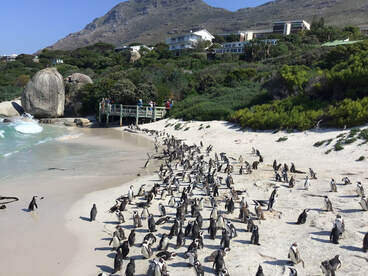 Location: SouthWestern Coast of Africa Status: Endangered Population: 50,000 African Penguin-Fun Facts The African Penguin is the only penguin species that breeds on the whole African continent. They breed and molt onshore, then remain at sea for four months returning to shore to repeat the same cycles. There are small muscles at the base of each feather which, when in water, hold feathers tightly to waterproof the body. When on land, they trap air for insulating warmth. These animals are found on Boulders Beach near Cape Town, South Africa.The African penguin is part of a genus with four species. This species is commonly known as the jackass penguins because of their distinct, braying calls. They also called black-footed penguin, and Cape penguin. This species of penguin is distinguished by a single band of black feathers cutting across the breast and a circle of featherless skin that completely surrounds each eye and is a light pink color. African penguins may be awkward on land, waddling upright with flippers held away from the body. They are, however, highly specialised for a life at sea and they are efficient swimmers that can reach speeds of 12.5 mph and cruise along at 2-4 mph and dive down to an astonishing depth of 420 ft. They may not be able to fly in air per say but the sure can fly though the water. Penguins communicate by vocalizing and performing physical behaviors called displays. They use many vocal and visual displays to communicate nesting territories, mating information, nest relief rituals, partner and chick recognition, and defense against intruders and preditors. Click on the sources below to learn more about the Blue Throated Macaw, what is being done to help their populations, and how you might get involved. (source: WWF, National Geographic, Britannica, Sea World and Aurifil) Check out the December Aurifil Color Builder patterns for the thread Club!
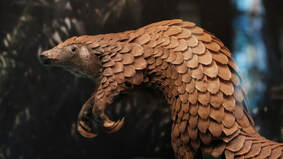 Location: Africa and Asia Status: Vulnerable to Critically Endangered Population: Unknown What’s scaly from tip to tail and can curl into a ball? Pangolins! They look like a cross between an anteater and an armadillo, and are sometimes referred to as scaly anteaters. These solitary, primarily nocturnal animals with very poor eyesight, and are easily recognized by their full armor of scales. A startled pangolin will cover its head with its front legs, exposing its scales to any predator. If touched or grabbed it will roll up completely into a ball, while the sharp scales on the tail can be used to lash out if attacked. Their sense of smell and sound is supreme and is used to hunt out termite mounds and ant hills. Pangolins are the most trafficked mammal in the world right now—with demand primarily in Asia and in growing amounts in Africa—for their meat and scales. There is also demand in the United States for pangolin products, particularly for their leather to be used in boots, bags, and belts. All eight pangolin species are protected under national and international laws, and two are listed as Critically Endangered on the IUCN Red List of Threatened Species. In June of 2020, China increased protection for native Chinese Pangolin to the highest level, which closed an important loophole for consumption of the species in-country. Additionally, the government will no longer allow the use of pangolin scales in traditional medicine, a big win given that an estimated 195,000 pangolins were trafficked in 2019 for their scales alone (Challender, et. al, 2020). Fun Facts Pangolins are the only mammal in the world to be covered from head to toe in scales. They eat an enormous 70 million insects every year and inhabit tropical forests, dry woodlands and the savannah. Some pangolins spend their time up in trees and others sleep in burrows underground. They are about the size of a small cat, are covered in brown scales, and have long, strong tails that can be used as a weapon. Like a skunk, pangolins can release a noxious smelling acid to deter predators. The name Pangolin is derived from the Malay word ‘pengguling’, which means ‘rolling up’. This is reference to the animal’s defence mechanism of rolling up into a tight little hardened ball when they are under threat. Click on the sources below to learn more about the Pangolin, what is being done to help their populations, and how you might get involved. (source: WWF, One Kind Planet, and Aurifil) Check out the November Aurifil Color Builder Thread Club Patterns!
The October edition of the Aurifil Thread Club is dedicated to the Cross River Gorilla. He looks a bit purple in this picture, which goes perfectly with this months Aurifil Thread Set. Location: Cameroon and Nigeria Status: Critically Endangered Population: 200 to 300 Cross RIver Gorilla-Facts The Cross River Gorilla is a subspecies of the western gorilla and one of the rare of the great apes. Their appearance is very similar in appearance to the western lowland gorilla. Subtle differences can be found in the skull and tooth dimensions. Cross River gorillas live in a region that human have been encroached upon. The gorilla’s forests territory are being decimated for timber, create fields for agriculture and livestock. Poaching also occurs far to often in the forests as well, and the loss of even a few of these gorillas has a detrimental effect on such a small population. The Cross River Gorilla is Africa’s most endangered great ape, with only between 200 and 300 of these elusive creatures left. Conservation efforts are underway in Cameroon and Nigeria to bring the tiny population of Cross River Gorillas back from the brink by tackling forest loss and poaching. They are a very elusive and wary group of gorillas which has made it difficult to research information Fun Fact How fast can a gorilla run you might ask? A gorilla can reach speeds of 20 miles at 25 mph per hour. Gorillas live in small groups called troops or bands. They sleep at night in nests, though you may be thinking of a birds nest, this nest is on the ground a quite a bit larger than a birds. The Cross River gorillas stand 4.7 to 5.5 feet tall and weigh between 220 and 440 pounds. Click on the sources below to learn more about the Cross River Gorilla, what is being done to help their populations, and how you might get involved. (source: WWF, One Kind Planet, New England Primate Conservancy and Aurifil) Check out the November Aurifil Color Builder Thread Club Patterns!
|
AuthorSurface Pattern Designer, Quilt Pattern Designer, Art Quilter, Nature Lover, Wife & Momma to one fur-baby Oscar! Archives
October 2022
Categories |


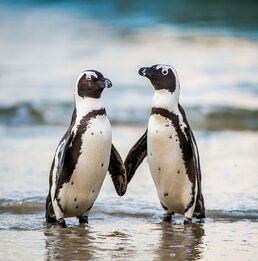
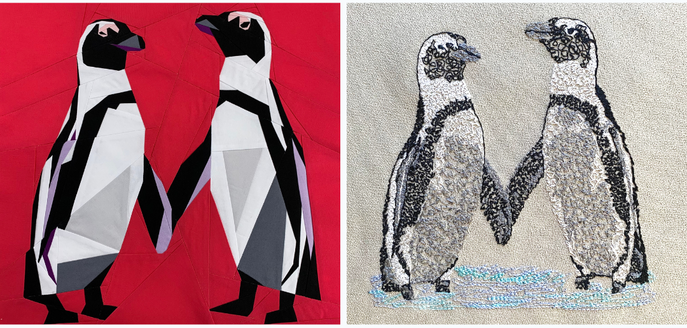
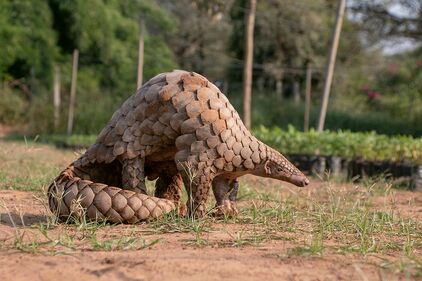
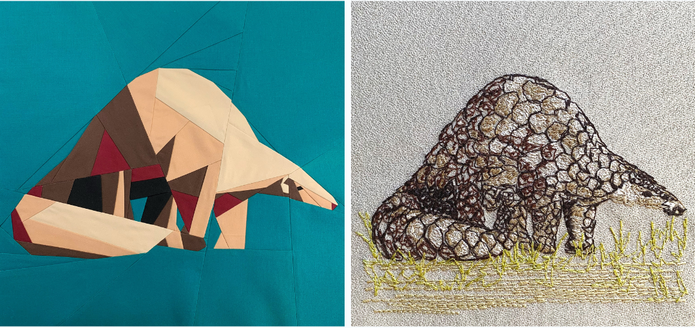
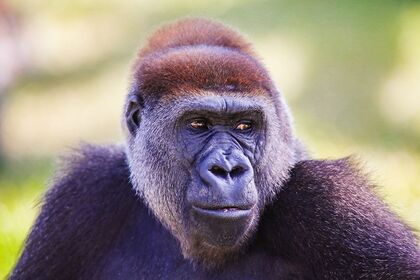
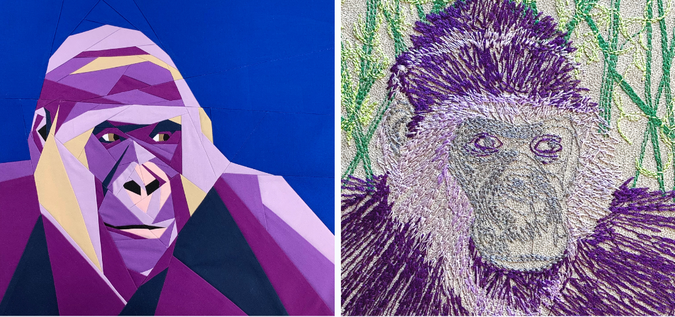
 RSS Feed
RSS Feed